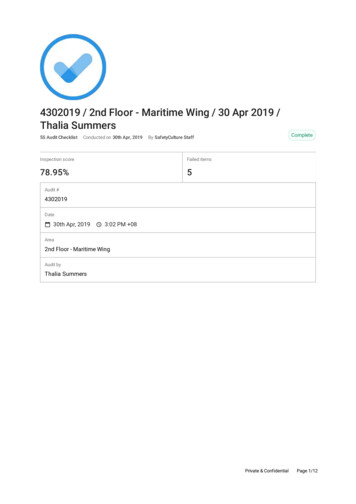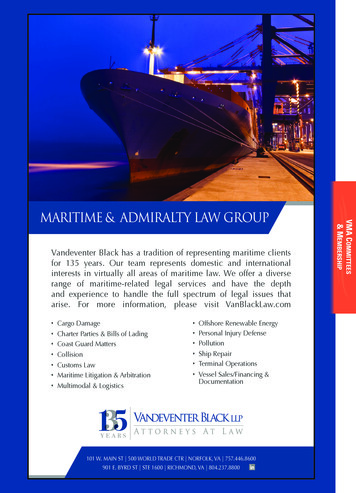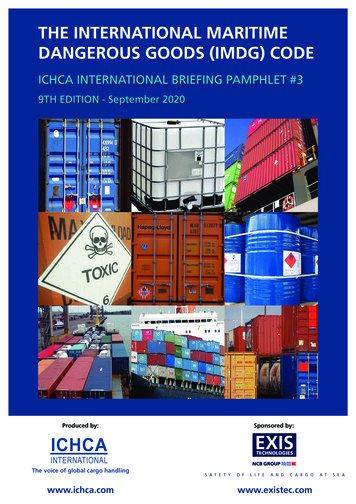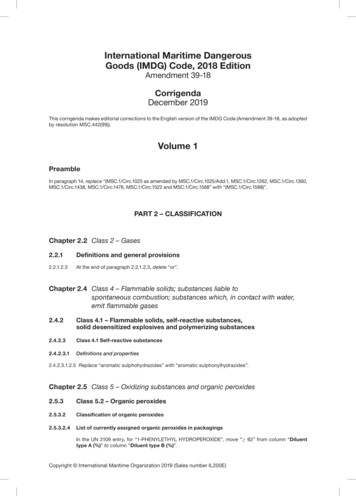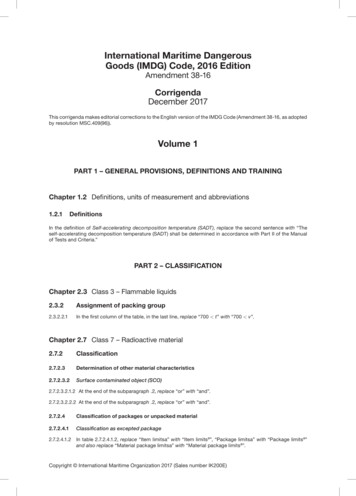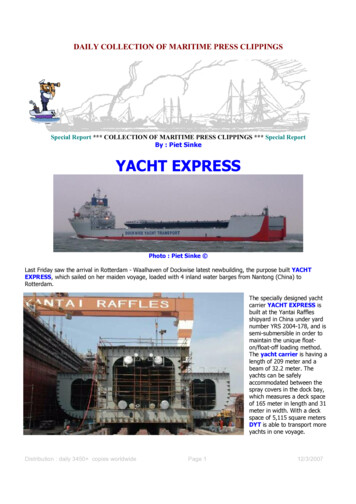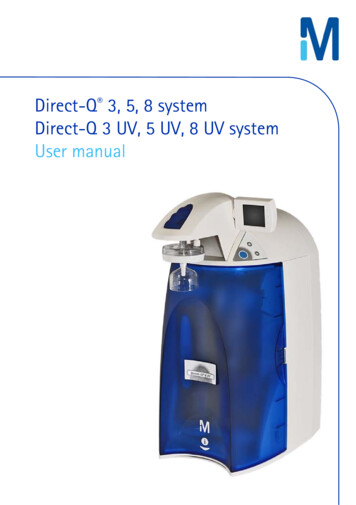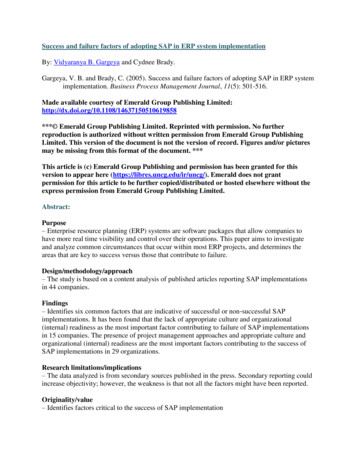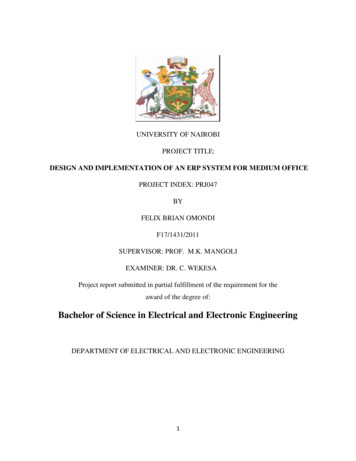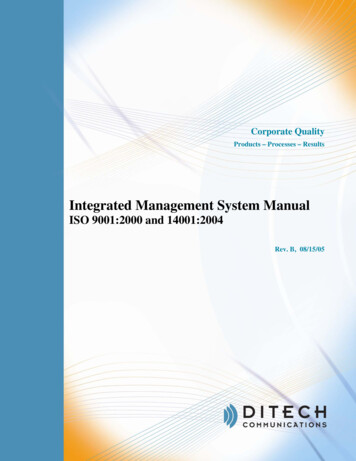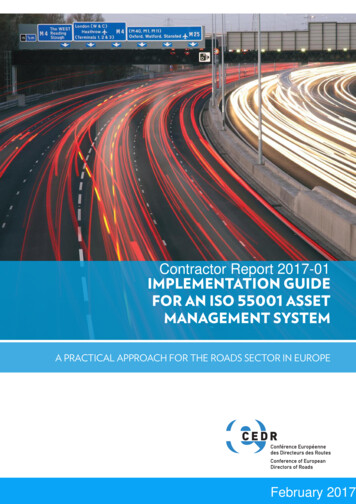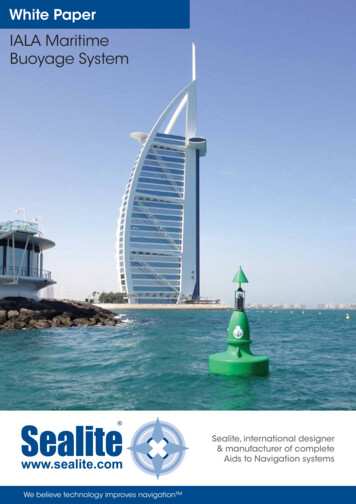
Transcription
White PaperIALA MaritimeBuoyage SystemSealite, international designer& manufacturer of completeAids to Navigation systemsWe believe technology improves navigation
Who is IALA?Established in 1957, IALA (International Association of Marine Aids and Lighthouse Authorities) is a nonprofit international technical association. IALA provides nautical expertise and advice. IALA encouragesits members to work together to harmonise aids to navigation worldwide and to ensure the movements ofvessels are safe, expeditious and cost effective whilst simultaneously protecting the environment.One of the ways IALA achieves this is by establishing technical committees which bring togetherexperts from more than 80 countries around the world. The work of these committees is to developrecommendations on technologies and practices which are available in publications such as IALARecommendations and Guidelines.IALA is chiefly known for its buoyage system. As early as 1976, there were more than 30 dissimilar buoyagesystems in use throughout the world. To avoid confusion and help create safe navigation to mariners ofdifferent regions IALA have created a worldwide buoyage system.Region A & Region BTo minimise the number of changes to existing systems and to meet conflicting requirements IALA decidedto create a system divided into two regions. The region followed is dependent on geographical location:Region A: Europe, Australia, New Zealand, Africa, the Gulf and some Asian countriesRegion B: North, Central & South America, Japan, North & South Korea and the PhilippinesWe believe technology improves navigation
Sealite Marine BuoysSealite Marine buoys are manufacturedon-site from rotationally-moulded, UV-stabilisedpolyethylene, and are designed to offer a lowmaintenance, high visibility solution to marinenavigation. Sealite supplies buoys from 400mmdiameter up to 3m diameterSealite Marine LanternsSealite offers a complete range of LED marinelanterns. Sealite marine lanterns are designed to bemaintenance free and have a service life up to 12years. With visible ranges from 1NM up to 26NM, ourlanterns are ideal for applications including lighthouses, beacons, channel marking and generalmarine applications.All Sealite products are designed to meet IALArecommendations for aids to navigation.Types of Navigation MarksThe different types of marks used in the pilotage ofvessels at sea are easily distinguished by:- Shape- Colour- Topmark by day- Colour and rhythm of the light by night.The five types of marks are:Lateral Marks: indicate the edge of a channelCardinal Marks: indicate the position of a hazardand the direction of safe waterIsolated Danger Marks: indicate a hazard toshippingSafe Water Marks: indicate the end of a channeland deep, safe water is aheadSpecial Marks: indicate an area or feature such asspeed restrictions or mooring areaLateral Marks are the only marks that differ byregion, the other four marks are common to bothRegion A and Region B.www.sealite.com info@sealite.com
Lateral MarksPORTPORTLateral marks define a channel and indicate the port and starboardsides of the navigation route to be followed into a waterway such asIALAIALARegion BRegion Aa harbour, river or estuary from seaward. The vessel should keep portmarks to its left and keep starboard marks to its right.If lateral marks are unable to be represented by a can or cone shapedbuoy they should carry the appropriate topmark.SEASEAAt the point where a channel divides, a modified lateral mark is used toindicate a ‘preferred’ channel (often a deep channel suitable for heavycommercial vessels) on one side and a secondary channel on the other. A preferred channel is indicatedby red and green horizontal bands on the lateral marker. If a vessel wants to use the ‘preferred’ channel theyobserve the top colour of the mark; a vessel wishing to use the secondary channel observes the bottomcolour. See ‘Preferred Channel to Starboard/Port’ in Table 1.1 and Table 1.2.Table 1.1 LATERAL MARKS: REGION APort Hand MarksStarboard Hand MarksColourRedGreenBuoy ShapeCylindrical (can), pillar or sparConical, pillar or sparSingle red cylinder (can)Single green cone, point upwardsRedGreenLight Rhythm (when fitted)Any apart from composite group flashing (2 1)Any apart from composite group flashing (2 1)Preferred Channel to StarboardPreferred Channel to PortColourRed with one broad green horizontal bandGreen with one broad red horizontal bandBUOYAGE DIRECTIONTopmark (if any)Light Colour (when fitted)Buoy ShapeCylindrical (can), pillar or sparConical, pillar or sparTopmark (if any)Single red cylinder (can)Single green cone, point upwardRedGreenComposite group flashing (2 1)Composite group flashing (2 1)BUOYAGE DIRECTIONLight Colour (when fitted)Light Rhythm (when fitted)Table 1.2 LATERAL MARKS: REGION BPort Hand MarksStarboard Hand MarksColourGreenRedBuoy ShapeCylindrical (can), pillar or sparConical, pillar or sparSingle green cylinder (can)Single red cone, point upwardsGreenRedLight Rhythm (when fitted)Any apart from composite group flashing (2 1)Any apart from composite group flashing (2 1)Preferred Channel to StarboardPreferred Channel to PortColourGreen with one broad red horizontal bandRed with one broad green horizontal bandBUOYAGE DIRECTIONTopmark (if any)Light Colour (when fitted)Cylindrical (can), pillar or sparConical, pillar or sparSingle green cylinder (can)Single red cone, point upwardLight Colour (when fitted)GreenRedLight Rhythm (when fitted)Composite group flashing (2 1)Composite group flashing (2 1)BUOYAGE DIRECTIONBuoy ShapeTopmark (if any)We believe technology improves navigation
Cardinal MarksA cardinal mark is used to signify a danger and showwhere the safest water can be found. Cardinal marksindicate the direction of safety as a compass directionrelative to the mark. A cardinal mark is named after thequadrant in which it is placed. Due to the unique waycardinal marks use the points of a compass to signalsafety, it makes them meaningful regardless of thedirection of the approaching vessel.Cardinal marks have distinctive black and yellowmarkings and topmarks.Cardinal marks can be used to show the following:- The deepest water on an area on the named side ofthe mark- The safe side on which to pass a danger- Draw attention to a feature in a channel such as abend, junction or end of a shoalTable 2.1 CARDINAL MARKS: REGION A & REGION BNorth Cardinal MarkEast Cardinal MarkColourBlack above yellowBlack with a single broad horizontal yellow bandBuoy ShapePillar or sparPillar or sparTopmark2 black cones, one above the other,pointing upward2 black cones, one above the other,base to baseLight Colour (when fitted)WhiteWhiteLight Rhythm (when fitted)VQ or QVQ(3) every 5 seconds orQ(3) every 10 secondsSouth Cardinal MarkWest Cardinal MarkColourYellow above blackYellow with a single broad horizontal black bandBuoy ShapePillar or sparPillar or sparTopmark2 black cones, one above the other,points downward2 black cones, one above the other,point to pointLight Colour (when fitted)WhiteWhiteLight Rhythm (when fitted)VQ(6) Long flash every 10 seconds orQ(6) Long flash every 15 secondsVQ(9) every 10 seconds orQ(9) every 15 secondsQ & VQ Light RhythmsQ and VQ refer to the rhythm of a flashing light. Q is a quick flashing light and VQ is the symbol for avery quick flashing light.Q Flash frequency is at least 50 or 60 flashes per minute (1.2 or 1 flashes per second)VQ Flash frequency is at least 100 or 120 flashes per minute (0.6 or 0.5 flashes per second)www.sealite.com info@sealite.com
Isolated Danger MarksAn isolated danger mark is used to indicate a hazard to shipping such as a submerged rock or wreckwhich has navigable water all around it. It is erected or moored above the hazard.The double sphere topmark is an important feature and needs to be visible by day. The topmarks should beas large as possible with the spheres clearly separated.Table 3.1 ISOLATED DANGER MARKS: REGION A & REGION BIsolated Danger MarkColourBlack with one or more broad horizontal red bandsBuoy ShapeOptional, but not conflicting with lateral marks; pillar orspar preferredTopmark2 black spheres, one above the otherLight Colour (when fitted)WhiteLight Rhythm (when fitted)Group flashing (2)Safe Water MarksSafe water marks indicate there is navigable water all around the mark including the end of a channel ormid channel, however, this mark does not mark a danger. They are the only mark to have vertical stripes.Table 4.1 SAFE WATER MARKS: REGION A & REGION BSafe Water MarkColourRed and white vertical stripesBuoy ShapeSpherical; pillar or spar with spherical topmarkTopmark (if any)Single red sphereLight Colour (when fitted)WhiteLight Rhythm (when fitted)Isophase, occulting, one long flash every10 seconds or Morse “A”Special MarksSpecial marks do not usually assist navigation but are used to indicate a feature such as recreation zones,speed limits, mooring areas or cable and pipe lines including outfall sewerage pipes.Table 5.1 SPECIAL MARKS: REGION A & REGION BSpecial MarkColourYellowBuoy ShapeOptional but not conflicting with navigational marksTopmark (if any)Single yellow ‘X’ shape (St Andrew’s Cross)Light Colour (when fitted)YellowLight Rhythm (when fitted)Any other than those described in cardinal, isolateddanger and safe water marksWe believe technology improves navigation
IALA Maritime Buoyage System ExamplesIALA Maritime Buoyage System - Region APreferred ChannelSecondary ChannelTO PORT/HARBOURNDirection ofBuoyageTO SEAIALA Maritime Buoyage System - Region BPreferred ChannelSecondary ChannelTO PORT/HARBOURNDirection ofBuoyageTO SEAThe information contained in this publication is advisory only. Please contact your local authority for rules and regulations particular to your region.For further information about IALA and the IALA Maritime Buoyage System please visit www.iala-aism.orgReferences:IALA Maritime Buoyage System, IALA Publications, viewed 3 May 2010, http://www.iala-aism.orgwww.sealite.com info@sealite.com
All Sealite products are manufactured to exactingstandards under strict quality control procedures.Sealite’s commitment to research and development,investing in modern equipment and advancedmanufacturing procedures has made us anindustry leader in solar marine lighting.By choosing Sealite you can rest assured you havechosen the very best.Experienced & Trained Personnel Worldwide Distribution Team Agile Manufacturing Product Innovation Precision Construction Total Quality Management ISO9001:2008 Rapid TurnaroundSealite Pty Ltd11 Industrial Drive,Somerville Vic 3912AUSTRALIAt: 61(0)3 5977 6128f: 61(0)3 5977 6124Sealite USA, LLC61 Business Park DriveTilton New Hampshire 03276USAt: 1 (603) 737 1311f: 1 (603) 737 1320Sealite United Kingdom Ltd11 Pinbush RoadLowestoft Suffolk NR33 7NLUNITED KINGDOMt: 44 (0) 1502 588026f: 44 (0) 1502 588047w: www.sealite.come: info@sealite.com Sealite Pty Ltd 2015.Sealite reserves the right to make changes in specifications and/or to discontinueany product at any time without notice or obligation and will not be liable for anyconsequences resulting from the use of this publication.
IALA Maritime Buoyage System - Region A N Preferred Channel Secondary Channel TO SEA TO PORT/HARBOUR Direction of Buoyage N IALA Maritime Buoyage System - Region B Preferred Channel Secondary Channel TO SEA TO PORT/HARBOUR Direction of Buoyage We believe technology improves navigation www.sealite.com o@sealitinf e.com . Sealite Pty Ltd 11 Industrial Drive,
